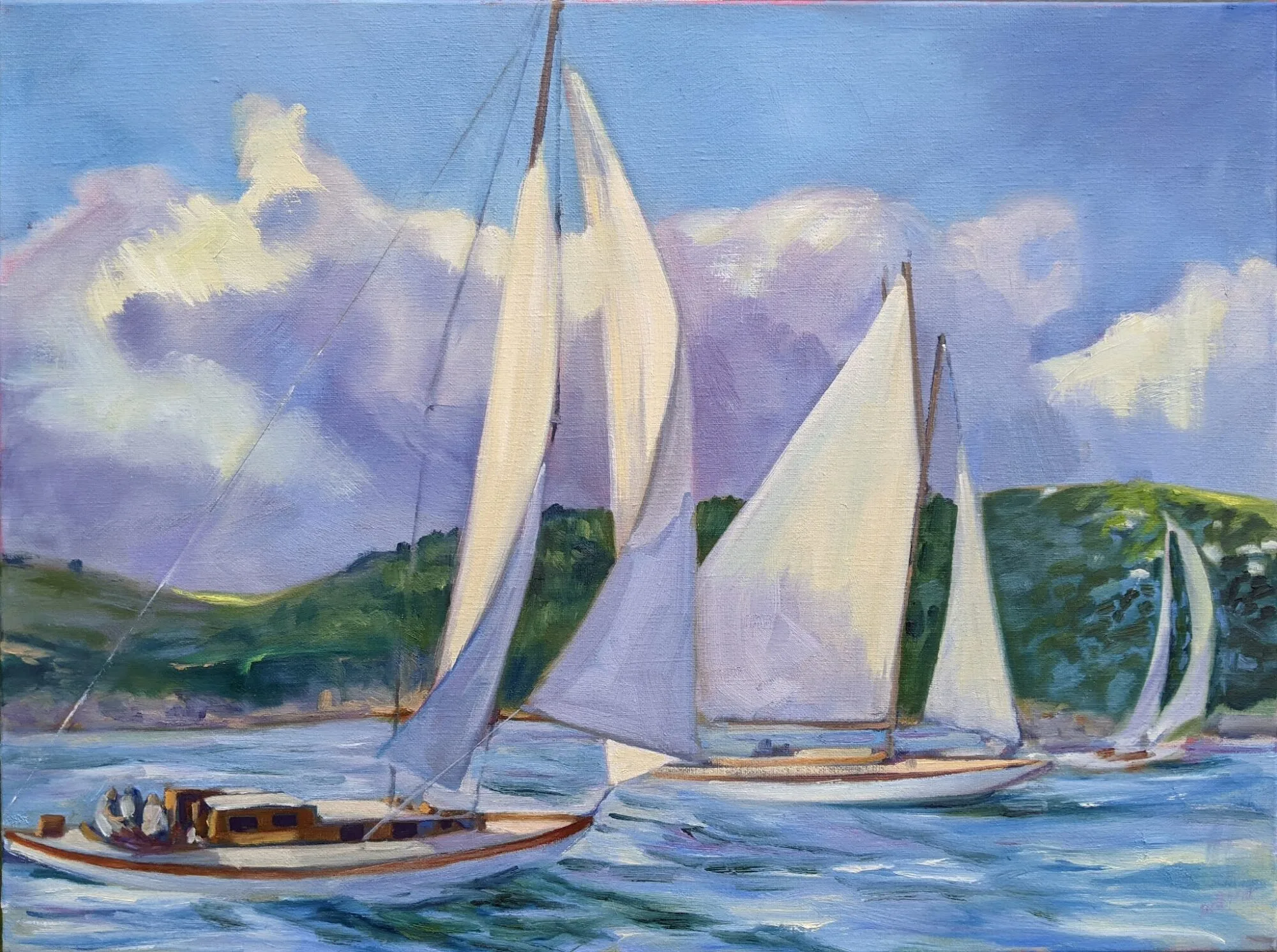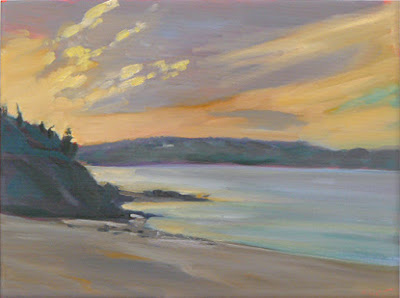Painting what you know, vs. what’s actually there.
| Sunset near Clark Island, by Carol L. Douglas |
 |
| A lobster pound at Tenants Harbor, by Carol L. Douglas |
 |
| Anticipation, by Carol L. Douglas |

Watch Me Paint: World-Class Art, World-Class Instruction
Painting what you know, vs. what’s actually there.
| Sunset near Clark Island, by Carol L. Douglas |
 |
| A lobster pound at Tenants Harbor, by Carol L. Douglas |
 |
| Anticipation, by Carol L. Douglas |
You can have it all. You’d just better be prepared to work very hard.
|
Clouds over Teslin Lake, Yukon Territory, by Carol L. Douglas. We did some icy camping here.
|
I recently was rejected from a residency I really wanted, in Gates of the Arctic National Park. (Rejection is how these things roll, so don’t worry about my feelings.) I’ve spent three months doing intensive training to ensure I could backpack my gear in the mountains. While I don’t think they discriminated on the basis of age, I will always wonder if it was a factor. Sixty-year-olds, in conventional wisdom, are not fit enough to climb mountains north of the Arctic Circle.
| This is the northernmost place I’ve ever painted, just a few miles from Gates of the Arctic National Park. |
| Blueberry barrens, Clary Hill, oil on canvas, by Carol L. Douglas. This is at Maine Farmland Trust Gallery until May 24. |
Young readers, you’ll reach not one but many forks in the road. At each juncture, you can choose between security and risk. If you’re not courageous enough to take risks at 20, 30, or 40, when are you going to develop courage?
I have a student right now who is a retired Army officer. She went to art school in her youth but chose a military nursing career. Since retiring, she pours her energies into being the best painter she can be. Because she’s dedicated, she’s succeeding. And I bet it keeps her young long after her peers have subsided into their final rest.
| Blueberry barrens, Clary Hill, watercolor, by Carol L. Douglas. This is at Maine Farmland Trust Gallery until May 24. |
The historical portrait is a great way to understand our legacy. Don’t consign it to the back room.
One of my favorite museums is the National Portrait Gallery (NPG) in London. That’s not because its collection is stellar—it’s piddling compared to the nearby National Gallery. It tells the story of Britain through art, and I love history.
 |
|
The Slave Gang, c. 1900, by unknown artist, glass magic lantern plate, published by The London Missionary Society, courtesy National Portrait Gallery.
|
 |
| Teddi-Jann Covell, me, and Truth Hawk model appropriate gear for winter painting. Photo courtesy Jennifer Johnson. |
| Finished paintings by students Mary Whitney and Teddi-Jann Covell. Photo courtesy Jennifer Johnson. |
 |
| Ed Buonvecchio with two pro tips: insulated LL Bean boots and his cap over his toque. You need a warm head and a sun visor in late winter. Photo courtesy Jennifer Johnson. |
| Robert Lichtman doubled his hat too, but was able to paint bare-handed. Photo courtesy Jennifer Johnson. |
 |
| Finished work by Colleen Lowe, Ed Buonvecchio and David Blanchard. Photo courtesy Jennifer Johnson. |
| Mary Whitney painting harbor ice. Photo courtesy Jennifer Johnson. |
| Camden harbor, by Carol L. Douglas |
Sometimes people ask me how we manage to get so many paintings done during an event. We avoid what my friend Brad Marshall called “flailing around.” That means those times when you seem to lose your way. We’ve all done it, when apparently everything we know falls out the bottom of our mind. I’ve written a simple protocol to avoid this. If you always work in this order, you’re less likely to flail around.
| Beach saplings, by Carol L. Douglas |
 |
| Parrsboro sunrise, by Carol L. Douglas |
| Eastport harbor, by Carol L. Douglas |
| Spring Mountain Lake, Carol L. Douglas |
Earlier this year, a young artist asked me about a gallery she was approaching. I gave her what advice I could and wished her well. This week she sent me a note telling me they’d chosen to represent another artist instead. One could accept that with equanimity, but she also sent me some images of the other artist’s work. Frankly, it’s schmaltz. It’s no more complex or insightful than the ‘art’ they sell at TJ Maxx/Home Goods. I can see why my friend was upset.
| Small boat harbor, Carol L. Douglas |
| Keuka Lake Vineyard, Carol L. Douglas, courtesy Kelpie Gallery. |
| Sentinel trees, Carol L. Douglas |
But Egon Schiele certainly could paint a lovely boat.
 |
|
Segelschiffe im wellenbewegtem Wasser (Der Hafen von Triest), 1907, Egon Schiele, private collection
|
 |
|
Boote im Hafen von Triest, 1908, Egon Schiele, courtesy Landesmuseum Niederösterreich
|
 |
|
Dampfer und Segelboote im Hafen von Triest, watercolor, pencil and gouache on Japan paper, 1912, Egon Schiele
|
 |
|
Die Brücke, 1913, Egon Schiele, private collection
|
| More work than they bargained for, by Carol L. Douglas |
 |
| Dinghies, Fish Beach, Monhegan, by Carol L. Douglas |
 |
| Drying sails, by Carol L. Douglas |
Ask the Manhattanite who’s emerging and who’s established, and you’re going to get a far different answer than if you ask in, say, Houston. Meanwhile, regional landscape art—including plein air—sells like mad.
 |
| Spring, by Carol L. Douglas |
Leonardo da Vinci painted two Madonnas set in caves. Why?
 |
|
Madonna of the Rocks, Leonardo da Vinci, c. 1483-86, courtesy of the Louvre.
|
We moderns are very good at seeing subconscious imagery in everything. In contrast, our ancestors communicated with universally-understood symbols. These represented an idea, a person, or even a relationship. Earlier this week, I came across a quotation from Leonardo da Vinci’snotebook, in which the distinction between symbol and subconscious gets a little fuzzy:
 |
|
Madonna of the Rocks, c. 1503-06, Leonardo da Vinci, courtesy National Gallery
|
Leonardo also painted St. Jerome in a cave, but everyone did that. Jerome translated his Bible into Latin in the cave where Jesus was born.
 |
|
St Jerome, c. 1480, unfinished, Leonardo da Vinci, courtesy the Vatican
|
 |
|
Madonna of the Carnation, 1478, Leonardo da Vinci, courtesy Alte Pinakothek. Isn’t this just a more stylized version of the same traps and dark passages as in the cave paintings?
|
 |
|
Apocalyptic scenes from da Vinci’s notebooks, c. 1517-18, Royal Collection Trust
|
 |
|
Dining Room in the Country, 1913, Pierre Bonnard, courtesy Minneapolis Institute of Art. Bonnard used small brush strokes, intense colors, and close values.
|
|
Wheatfield with Crows, 1890, Vincent van Gogh, courtesy Van Gogh Museum, Amsterdam. The motion in the painting is created by his brush strokes.
|
 |
|
Waterlilies, c. 1915, Claude Monet, courtesy Neue Pinakothek, Munich. Monet makes no attempt to hide his drawing in this painting. The brushstrokes are wet-over-dry.
|
 |
|
Lady Agnew of Lochnaw, 1892, John Singer Sargent, courtesy Scottish National Gallery, Edinburgh. Note that the transparent sleeves are not produced by glazing, but with direct, long brushstrokes.
|